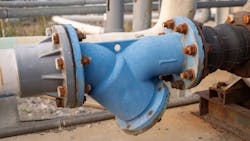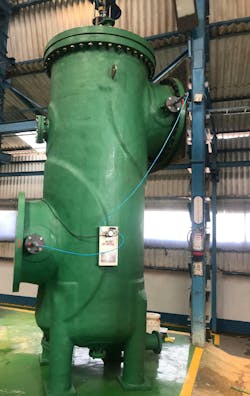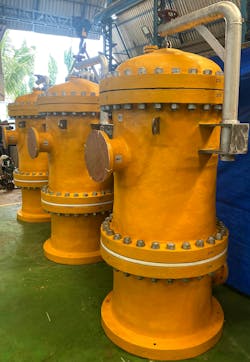Deterring Corrosion With Fiber-Reinforced Plastic (FRP) Industrial Strainers
Industrial strainers are essential for screening out debris and large particulates to protect crucial downstream equipment and processes in myriad applications. Strainers are used not only in the treatment of seawater and wastewater but also to remove debris from process and cooling tower water. Applications can range from desalination, wastewater treatment, and irrigation to power generation and the production of food, pharmaceuticals, consumer, and industrial products.
Although standard carbon steel construction is adequate for typical use, corrosive environments such as those involving seawater, erosive slurries, or aggressive chemicals can quickly corrode conventional equipment. This can lead to potential issues in safety, quality, and compliance as well as production downtime, requiring premature strainer component replacement.
In many industries, duplex or super duplex stainless-steel construction is used to resist corrosion, but at considerable cost. Now, a wide range of industrial facilities are turning to a more economic, durable alternative.
“Today, a much more cost-effective option is to use Fiber-Reinforced Plastic (FRP) strainers that are specifically designed to be resistant to corrosive environments at a fraction of the cost of duplex or super duplex stainless steels,” says Robert Presser, Vice President of Acme Engineering Prod., Inc., a North American manufacturer of industrial self-cleaning strainers. The company is an ISO 9001:2015 certified manufacturer of environmental controls and systems with integrated mechanical, electrical, and electronic capabilities.
FRP is a composite material made up of polymer and supported with fibers for added strength. FRP is already widely used for applications such as the power plant piping used to carry seawater for once-through process cooling.
Within industrial markets, OEMs are now using FRP in various applications where superior corrosion resistance is required at lower cost. As an example, Acme offers the option of using exceptionally corrosion-resistant FRP for external strainer construction, including the pressure vessel itself. The internal mechanism is still manufactured with super duplex or similar steels.
Due to the FRP's strength, the material can also be used to build to ASME BPVC Section X standards, which establishes requirements for the fabrication of fiber‐reinforced plastic pressure vessels. Acme has already used FRP for pressure vessel applications up to 300 PSI.
“Industries can save approximately half the cost or more when the strainer's intake vessels and piping are built with FRP, and only the internals are constructed with super duplex,” says Presser.
To meet industrial requirements, Acme's FRP division designs and manufactures various types of FRP, simplex, duplex, automatic scraper, and backflush filters. To help ensure compliance with specifications, the OEM provides detailed engineering, including 3D modeling of FRP piping, piping flexibility/general stress analysis, and piping layout/isometrics. In addition, the OEM provides complete skids with piping, valves, and instrumentation along with PLC control, as needed.
According to Presser, an automatic, self-cleaning, scraper strainer is often used with FRP construction when cost-effective corrosion resistance is necessary and minimal oversight is desired. In the case of the OEM’s automatic scraper strainer, a motorized unit is designed to continually remove both very large and very small, suspended solids from seawater, wastewater, and process streams.
Cleaning is accomplished by a spring-loaded blade and brush system, managed by a fully automatic control system. Four scraper brushes rotate at 8 RPM, resulting in a cleaning rate of 32 strokes per minute. The scraper brushes get into wedge-wire slots and dislodge resistant particulates and solids. This approach enables the scraper strainers to resist clogging and fouling when faced with large solids and high solids concentration. It ensures a complete cleaning and is very effective against organic matter "biofouling."
Although industrial facilities have long employed industrial strainers constructed of special stainless steels to resist corrosion, using FRP can be just as effective at a much lower cost. When used with advanced, self-cleaning scraper strainers, downstream equipment, and processes can be effectively protected for the long term without premature component replacement or excessive oversight.
For more info, visit Acme Engineering Prod. Inc. at acmeprod.com; phone Robert Presser, Vice President at (518) 236-5659; fax: (518) 236-6941; mail Acme at Trimex Building, Route 11, POB 460 PMB 10, Mooers, New York 12958. In Canada phone: (514) 342-5656; fax: (514) 342-3131; mail them at 5540 Rue Paré, Mont-Royal, QC H4P 2M1.
About the Author

Del Williams
Del Williams is a technical writer based in Torrance, California. He writes about health, business, technology, and educational issues and has an M.A. in English from C.S.U. Dominguez Hills.


